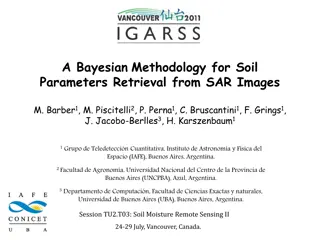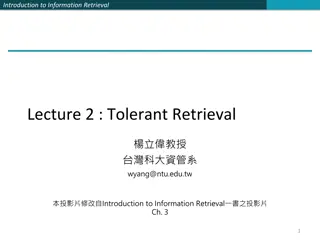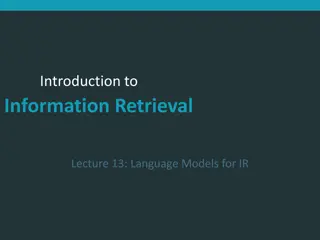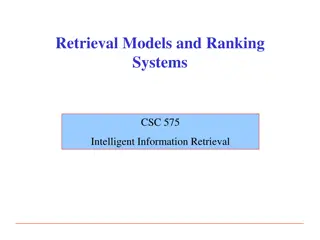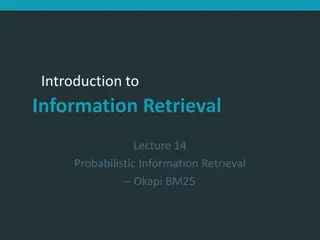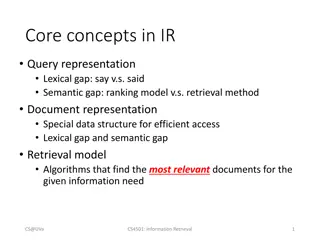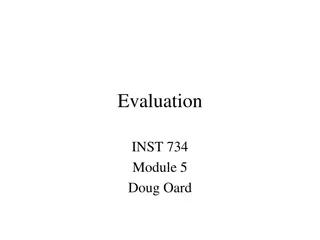Ranked Retrieval Models in Information Retrieval
Ranked retrieval in information retrieval systems offers an ordered list of top documents in response to free text queries, eliminating the issues of Boolean searches like "feast or famine". Users benefit from not being overwhelmed by vast result sets, as only the top results are presented. Scoring forms the basis of ranked retrieval, ensuring users receive relevant and useful information efficiently.
Download Presentation

Please find below an Image/Link to download the presentation.
The content on the website is provided AS IS for your information and personal use only. It may not be sold, licensed, or shared on other websites without obtaining consent from the author. Download presentation by click this link. If you encounter any issues during the download, it is possible that the publisher has removed the file from their server.
E N D
Presentation Transcript
Vector Space Model Michael T. Goodrich University of California, Irvine Some slides adapted from notes by Ben Horowitz and Guy Blelloch, and slides from Pandu Nayak and Prabhakar Raghavan (Senior Vice President at Google responsible for Google Search, Assistant, Geo, Ads, Commerce, and Payments products).
Ranked retrieval Thus far, our queries have all been Boolean. Documents either match or don t. Good for expert users with precise understanding of their needs and the collection. Also good for applications: Applications can easily consume 1000s of results. Not good for the majority of users. Most users incapable of writing Boolean queries (or they are, but they think it s too much work). Most users don t want to wade through 1000s of results. This is particularly true of web search.
Images from https://healthyfitnessmeals.com/one-pot-chicken-spaghetti/ and https://theconversation.com/feast-then-famine-how-fasting-might-make-our-cells-more-resilient-to-stress-38808 Problem with Boolean search: feast or famine Boolean queries often result in either too few (=0) or too many (1000s) results. Query 1: standard user dlink 650 : 200,000 hits Query 2: standard user dlink 650 cash : 0 hits It takes a lot of skill to come up with a query that produces a manageable number of hits. AND gives too few; OR gives too many
Ranked retrieval models Rather than a set of documents satisfying a query expression, in ranked retrieval, the system returns an ordering over the (top) documents in the collection for a query Free text queries: Rather than a query language of operators and expressions, the user s query is just one or more words in a human language In principle, there are two separate choices here, but in practice, ranked retrieval has normally been associated with free text queries and vice versa 4
Feast or famine: not a problem in ranked retrieval When a system produces a ranked result set, large result sets are not an issue Indeed, the size of the result set is not an issue We just show the top k ( 10) results We don t overwhelm the user Premise: the ranking algorithm works Image from https://www.timeshighereducation.com/features/top-20-ways-to-improve-your-world-university-ranking/410392.article
Scoring as the basis of ranked retrieval We wish to return in order the documents most likely to be useful to the searcher How can we rank-order the documents in the collection with respect to a query? Assign a score say in [0, 1] to each document This score measures how well document and query match . Image from https://www.turtlediary.com/lesson/probability.html
Query-document matching scores We need a way of assigning a score to a query/document pair Let s start with a one-term query If the query term does not occur in the document: score should be 0 The more frequent the query term in the document, the higher the score (should be) We will look at a number of alternatives for this.
Take 1: Jaccard similarity Recall: A commonly used measure of overlap of two sets A and B: jaccard(A,B) = |A B| / |A B| jaccard(A,A) = 1 jaccard(A,B) = 0if A B = 0 A and Bdon t have to be the same size. Always assigns a number between 0 and 1. Images from https://en.wikipedia.org/wiki/Jaccard_index
Issues with Jaccard for scoring It doesn t consider term frequency (how many times a term occurs in a document) Rare terms in a collection are more informative than frequent terms. Jaccard doesn t consider this information We need a more sophisticated way of incorporating term frequency Image from https://www.r-bloggers.com/2020/05/learning-tfidf-with-political-theorists/
Recall: Binary term-document incidence matrix Antony and Cleopatra Julius Caesar The Tempest Hamlet Othello Macbeth 1 1 0 0 0 1 Antony 1 1 0 1 0 0 Brutus 1 1 0 1 1 1 Caesar 0 1 0 0 0 0 Calpurnia 1 0 0 0 0 0 Cleopatra 1 0 1 1 1 1 mercy 1 0 1 1 1 0 worser Each document is represented by a binary vector {0,1}|V|
Term-document count matrices Consider the number of occurrences of a term in a document: Each document is a count vector in v: a column below Antony and Cleopatra Julius Caesar The Tempest Hamlet Othello Macbeth 157 73 0 0 0 0 Antony 4 157 0 1 0 0 Brutus 232 227 0 2 1 1 Caesar 0 10 0 0 0 0 Calpurnia 57 0 0 0 0 0 Cleopatra 2 0 3 5 5 1 mercy 2 0 1 1 1 0 worser
Bag of words model Vector representation doesn t consider the ordering of words in a document John is quicker than Mary and Mary is quicker than John have the same vectors This is called the bag of words model. In a sense, this is a step back: The positional index was able to distinguish these two documents. We will look at recovering positional information later in this course. For now: bag of words model
Term frequency, tf The term frequency tft,d of term t in document d is defined as the number of times that t occurs in d. We want to use tf when computing query- document match scores. But how? Raw term frequency is not what we want: A document with 10 occurrences of the term is more relevant than a document with 1 occurrence of the term. But not 10 times more relevant. Relevance does not increase proportionally with term frequency.
Log-frequency weighting of tf The log frequency weight of term t in d is log10 (1 + tft,d) tf: 0 0, 9 1, 99 2, 999 3, 9999 4, Score for a document-query pair: sum over terms t in both q and d: d q t (1 = + log tf t) , Score d The score is 0 if none of the query terms is present in the document.
Document frequency Rare terms are more informative than frequent terms Recall stop words Consider a term in the query that is rare in the collection (e.g., porridge) A document containing this term is very likely to be relevant to the query porridge We want a high weight for rare terms like porridge. Image from https://www.thermofisher.com/blog/metals/a-snapshot-of-the-worlds-rarest-metals/
Document frequency Frequent terms are less informative than rare terms Consider a query term that is frequent in the collection (e.g., high, increase, line) A document containing such a term is more likely to be relevant than a document that doesn t But it s not a sure indicator of relevance. For frequent terms, we want high positive weights for words like high, increase, and line But lower weights than for rare terms. We use document frequency (df) to capture this.
idf weight N = the number of documents dft is the document frequency of t: the number of the N documents that contain t dft is an inverse measure of the informativeness of t dft N We define the idf (inverse document frequency) of t by ( log idf 10 t = /df ) N t We use log (N/dft) instead of N/dftto dampen the effect of idf. It turns out the base of the log is immaterial.
idf example, suppose N = 1 million term dft idft calpurnia 1 6 animal 100 4 sunday 1,000 3 fly 10,000 2 under 100,000 1 the 1,000,000 0 log = idf ( /df ) N 10 t t There is one idf value for each term t in a collection.
Effect of idf on ranking Does idf have an effect on ranking for one- term queries, like iPhone idf has no effect on ranking one term queries idf affects the ranking of documents for queries with at least two terms For the query capricious person, idf weighting makes occurrences of capricious count for much more in the final document ranking than occurrences of person.
Term freqency vs. Document frequency The collection frequency of a term t is the number of occurrences of t in the collection, counting multiple occurrences. Example: N = 20,000 Word Term frequency in doc. Document frequency of term log (1 + tf) log (N / df) insurance 108 3997 2.04 0.70 try 104 8760 2.02 0.36 Which word is a better search term (and should get a higher weight)? (Hint: insurance is twice as rare.)
tf-idf weighting The tf-idf weight of a term is the product of its tf weight and its idf weight. tf 1 log( w , t d t + = ) log ( / df ) N , 10 d t Best known weighting scheme in information retrieval Note: the - in tf-idf is a hyphen, not a minus sign! Alternative names: tf.idf, tf x idf Increases with the number of occurrences within a document Increases with the rarity of the term in the collection
Score for a document given a query Score(q,d) = tf.idft,d t q d There are many variants How tf is computed (with/without logs) How idf is computed Whether the terms in the query are also weighted But the score is always a sum of tf.idf values 22
Binary count weight matrix Antony and Cleopatra Julius Caesar The Tempest Hamlet Othello Macbeth 5.25 3.18 0 0 0 0.35 Antony 1.21 6.1 0 1 0 0 Brutus 8.59 2.54 0 1.51 0.25 0 Caesar 0 1.54 0 0 0 0 Calpurnia 2.85 0 0 0 0 0 Cleopatra 1.51 0 1.9 0.12 5.25 0.88 mercy 1.37 0 0.11 4.15 0.25 1.95 worser Each document is now represented by a real-valued vector of tf-idf weights R|V|
Documents as vectors So we have a |V|-dimensional vector space Terms are axes of the space Documents are points or vectors in this space Very high-dimensional: tens of millions of dimensions when you apply this to a web search engine These are very sparse vectors - most entries are zero.
Queries as vectors Key idea 1: Do the same for queries: represent them as vectors in the space Key idea 2: Rank documents according to their proximity to the query in this space proximity = similarity of vectors proximity inverse of distance Recall: We do this because we want to get away from the you re-either-in-or-out Boolean model. Instead: rank more relevant documents higher than less relevant documents
Formalizing vector space proximity First cut: distance between two points ( = distance between the end points of the two vectors) Euclidean distance? Euclidean distance is a bad idea . . . . . . because Euclidean distance is large for vectors of different lengths.
Why distance is a bad idea The Euclidean distance between q and d2 is large even though the distribution of terms in the query q and the distribution of terms in the document d2 are very similar.
Use angle instead of distance Thought experiment: take a document d and append it to itself. Call this document d . Semantically d and d have the same content The Euclidean distance between the two documents can be quite large The angle between the two documents is 0, corresponding to maximal similarity. Key idea: Rank documents according to angle with query.
From angles to cosines The following two notions are equivalent. Rank documents in decreasing order of the angle between query and document Rank documents in increasing order of cosine(query,document) Cosine is a monotonically decreasing function for the interval [0o, 180o]
From angles to cosines But how and why should we be computing cosines?
Length normalization A vector can be (length-) normalized by dividing each of its components by its length for this we use the L2 norm: = x 2 2 iix Dividing a vector by its L2 norm makes it a unit (length) vector (on surface of unit hypersphere) Effect on the two documents d and d (d appended to itself) from earlier slide: they have identical vectors after length-normalization. Long and short documents now have comparable weights
cosine(query,document) Unit vectors Dot product V V q d q d q d i i = = = = cos( , ) q d 1 i q q d d V 2 2 q d i i = = 1 1 i i qi is the tf-idf weight of term i in the query di is the tf-idf weight of term i in the document cos(q,d) is the cosine similarity of q and d or, equivalently, the cosine of the angle between q and d.
Cosine for length-normalized vectors For length-normalized vectors, cosine similarity is simply the dot product (or scalar product): V cos(q ,d ) =q d = qidi i=1 for q, d length-normalized. 33
Cosine similarity illustrated Image from https://shannonlong2014.wordpress.com/2014/06/01/ir-models-vector-space-model/
Cosine similarity amongst 3 documents How similar are the novels SaS: Sense and Sensibility PaP: Pride and Prejudice, and WH: Wuthering Heights? term SaS PaP WH affection 115 58 20 jealous 10 7 11 gossip 2 0 6 wuthering 0 0 38 Term frequencies (counts) Note: To simplify this example, we don t do idf weighting.
3 documents example contd. After length normalization term affection jealous gossip wuthering Log frequency weighting term SaS affection 3.06 jealous 2.00 gossip 1.30 wuthering 0 PaP 2.76 1.85 WH 2.30 2.04 1.78 2.58 SaS 0.789 0.515 0.335 PaP 0.832 0.555 WH 0.524 0.465 0.405 0.588 0 0 0 0 0 cos(SaS,PaP) 0.789 0.832 + 0.515 0.555 + 0.335 0.0 + 0.0 0.0 0.94 cos(SaS,WH) 0.79 cos(PaP,WH) 0.69 Why do we have cos(SaS,PaP) > cos(SaS,WH)?
tf-idf weighting has variants Why is the base of the log in idf immaterial? From https://en.wikipedia.org/wiki/Tf%E2%80%93idf
Summary vector space ranking Represent the query as a weighted tf-idf vector Represent each document as a weighted tf-idf vector Compute the cosine similarity score for the query vector and each document vector Rank documents with respect to the query by score Return the top K (e.g., K = 10) to the user









